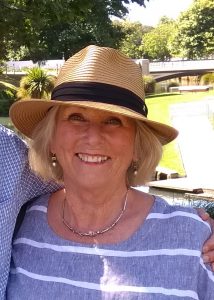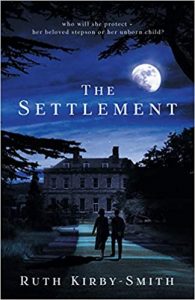THE SETTLEMENT BY RUTH KIRBY-SMITH
 ‘I am going to write a book’ was my mantra throughout life, but university, travel, career and children got in the way. I tried to start writing a few times, but it just petered out. The main reason was I did not have a subject that gripped me. My reading has always been eclectic – l’ll read everything from Booker prize winners to thrillers to autobiographies with no clear favourite. So, what was I to write about?
‘I am going to write a book’ was my mantra throughout life, but university, travel, career and children got in the way. I tried to start writing a few times, but it just petered out. The main reason was I did not have a subject that gripped me. My reading has always been eclectic – l’ll read everything from Booker prize winners to thrillers to autobiographies with no clear favourite. So, what was I to write about?
The inspiration came when my father died. He had an unusual childhood and we grew up hearing stories of how he was fostered at three days old, then at the age of ten, he was taken back by his wealthy parents to get an education. He then arranged to be ‘kidnapped’ by two of his foster sisters because he did not like his new school or life with his biological parents. I believed all the stories without question as a child but now, in middle age, I began to question it all. I researched his family and came up with some new and interesting information which led me to investigate the historical period.
I had given up history at the age of 14 after being cheeky to the toughest history teacher in Methodist College Belfast. I was absolutely roasted by him. I shrugged it off, but I had the good sense to drop the subject. When I researched the historical period of my father’s childhood and the decade before I found a fascinating history of the anti-home rule movement in Northern Ireland, which I knew nothing about. With the combination of an interesting family background and a volatile historical period, I had the basis for my book.
I wrote in a white heat and the story went onto the page in a long easy flow, but the early drafts did not read very well. They were clunky. My studies had been in arts and social sciences, so I had been used to writing essays, but I then took a Master’s in City Planning and spent years doing research in that field. I had been taught to produce technical reports – not essays – and it showed in my early attempts at writing. I had to reprogramme myself to tell stories. A friend pointed out to me that I always had a funny story to tell when we met for tennis and with that in mind, I was able to find ‘a voice’. It was a distinctly Irish voice with local words and expressions because, although I have lived in England longer than my native Northern Ireland, I feel Irish to the core.
The background for the main characters in the book was based on the real life events of my grandparents, but the characters were totally fictitious. In dealing with the anti-home rule movement, I wanted to have a counterpoint with an independent point of view. The main character, Sarah, is strong, free thinking and feisty, is influenced by the suffragettes and represents all the arguments for the home rule movement. My grandfather was a wealthy self-made man like one of the main characters John, but thankfully it was not due to gunrunning!
I speckled the book with characters and names from my childhood. The colonel is based on an old man who worked for my aunt Jane. There’s a story at the beginning of the book about him being rude in front of ladies from the churc. This did in fact happen, except it was in the presence of a local titled lady. Violet, the cook, is based on my lovely, irreverent, kind aunt and Reverend Lavery was my childhood church minister.
I also include places I remember well such as Queen’s University and Methodist College Belfast, and there is mention of the Titanic which was being built in the shipyard at Belfast at that time. This particular chapter was written when the book was finished, and I happened to be researching something unrelated. I realised that alongside politics there was the suffragette movement, the advancement in women’s education and the building of one of the most famous ships in the world and I had not included them. The chapter was written in two days and edited on the third.
The plot was much more difficult, and it changed over time. I started the book with my father’s story – now chapters three and four – but felt I needed something to really grab the reader and create a mystery, so I wrote what are now chapters one and two, moving the time scale to within my own lifetime. This enabled me to write about my experience of being at university during The Troubles and the cultural shift I experienced when travelling to America to work in the summers, or Cambridge to visit friends who seemed to be living in such different worlds.
When I write the visions of people, places, expressions and reactions are very clear in my head. I see it first and then translate it into words. I think this comes across as readers often say The Settlement would be perfect for a film or a tv series. I wish…….
—
Ruth Kirby-Smith grew up in Northern Ireland and studied politics at Queen’s University, Belfast during the civil rights era. Ruth is a successful businesswoman who has worked in City planning in London and planning research at Cambridge University, and founded a renowned baby products company. In retirement, she decided to look into her family history. The Settlement is her first book.
THE SETTLEMENT
 Olivia returns home for her grandmother Sarah’s funeral in 1984. Sarah was a loving matriarch in the village of Lindara. So why would someone spit at her coffin?
Olivia returns home for her grandmother Sarah’s funeral in 1984. Sarah was a loving matriarch in the village of Lindara. So why would someone spit at her coffin?
In 1910 Sarah marries Theo, a widower deeply involved in the anti-home rule movement. She promises to keep her personal views private.
One night in 1914 Sarah and her stepson Samuel are unintentionally drawn into gunrunning, which compromises her principles.
Theo slides into dementia but pesters Sarah constantly about something called the settlement. She is mystified until one morning in 1919, when she opens a letter and gets the biggest shock of her life.
As the truth unfolds events occur to change her life forever, and she is torn between protecting Samuel and her unborn child.
After the funeral Olivia finds a red leather notebook to discover that Sarah has taken the secret of that fateful night in 1919 to her grave.
BUY HERE
Category: Contemporary Women Writers, How To and Tips



